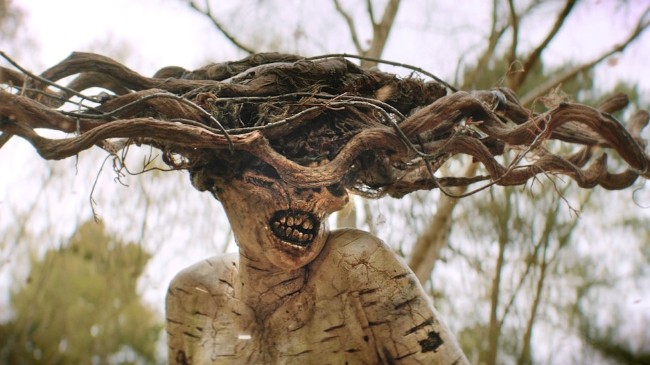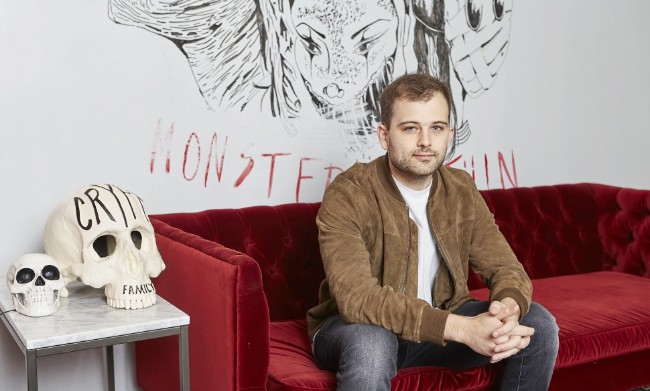
Crypt TV CEO and founder Jack Davis wants to scare the sh*t out of you, but not with a film that you’re forced to sit through in a crowded movie theater. Nope, Davis wants to bring the scares to you, and he’s doing it by hijacking the one thing most people can’t live without — their phones.
Davis launched Crypt TV, a company who hopes to be the “Marvel of monsters” for the next generation, in April 2015 with the help of friend and filmmaker Eli Roth. When Davis was fresh out of college, the duo had an idea — a contest aimed at horror fans, asking them to create a horror scene in just a few seconds. The “6 Second Scare” challenge was hosted on Vine, and it received tens of thousands of entries. That’s how Davis knew he was onto something and that the rest of the entertainment industry was falling behind.
“All of a sudden cable is not so necessary, and people are streaming things. People are watching stuff on YouTube,” Davis tells UPROXX of the change he saw in the way his peers were consuming media. “I watched all these consumer habits shift, but I did not see the appropriate reaction to it in L.A.”
After the success of the Vine challenge and with the backing of Roth and an investment from Jason Blumhouse (a producer of many horror masterpieces including Jordan Peele’s Get Out), Davis started Crypt TV. The company hoped to subvert traditional entertainment avenues (think long-form TV shows and feature films) and, instead, build an audience of mobile users by crafting monsters and having them interact with fans online.
Today, Crypt TV has over 11 million followers across several social media platforms, over 2 million subscribers on YouTube, and has hosted short-story episodes on Facebook and Netflix, but when Davis first pitched the idea of monsters being the draw, he ran into some roadblocks.
“There’s a little more respect for digital and what’s happening there now,” Davis says. “But I can tell you the difference between how people looked at this platform in 2016 in the industry, versus now in 2018, it’s night and day.”

Part of the reason for that difference is due to Crypt TV — which focuses on creating short, 10-minute horror scenes optimized for mobile — sitting within the genre it’s housed in. Horror is experiencing a bit of a renaissance these days with films like Get Out and John Krasinski’s A Quiet Place not only performing well at the box office but earning praise among industry insiders.
“I don’t want to say the genre has evolved is, because a lot of other great horror movies existed before now,” Davis says. “You’ve got George Romero’s Night of the Living Dead. That story told a lot of things about racism in America, decades ago. I always think that the best horror movies have told very powerful, important stories. We’ve had a nice renaissance in the last few years that reminded people that the best horror stories are like the best drama stories, or the best comedy stories, which is they’re great stories about characters, and the genre you’re in gives you a fun structure to accentuate some of those things.”
Another reason people weren’t keen on Crypt TV’s idea of an interactive, monster-driven model was because of where Davis wanted it to live. Now, it’s hard to imagine the resistance to mobile-marketing and the disbelief that a profit could be made from an audience on media, but a few years ago, that’s the kind of thinking Davis and his team were up against.
Giggles the Clown, a maniacal woman in pigtails, blood-splattered tutus, and a pointed Cheshire grin, is one of the company’s best-performing “monsters.” She has millions of followers on Facebook and Instagram and communicates in character. She attends red carpet events and hosts Facebook Live chats. She is, for all intents and purposes, an Instagram influencer in a macabre costume, and she’ll appear in short stories and episodes housed on Crypt TV sometimes, too. That fluidity, between an interactive social media personality and a fictional genre character, didn’t seem possible a few years ago.
“We really get amazing feedback from our audience, because we’re speaking directly to our audience,” Davis explains. “We have to nurture this community, and we’ve been nurturing it for years. We watched it grow up. We’re growing up with them.”
That’s not to say great story-telling isn’t a priority for Crypt TV. Fan pages for their monsters might rack up Youtube views, but the company puts as much thought into the stories that scare people as they do the characters. The Birch, a Webby-award-winning short hosted on Facebook, tells the story of a sentient tree who protects a kid from bullies. Sunny Family Cult follows a young woman fighting against the expectations of her family, who happens to be a clan of serial-killers. The Door in the Woods charts the journeys of a group of kids who open a mysterious door and unleash a hellish monster on the world. Each installment tops out in the five-to-ten-minute range and addresses universal themes: Grief, prejudice, bullying. Their brevity holds their intended audience’s attention, and they’re marketed with monsters to set them apart from the thousands of other creators flocking to social media now.
“A young audience has a big ability to switch,” Davis explains. “When you’re in a movie, you bought that ticket, you’re not going to walk out in the first five minutes, most likely. You made your investment. When you’re starting something on YouTube, people can click out on the right-hand tab there easily, or they can shut off their computer, or they can check their phone. You really need to earn their interest and attention. We kind of hint to you what the story is about at the beginning, and then weave it in throughout, because that’s the way we tell stories that’s different.”
Kate Krantz, Crypt TV’s Chief Content Officer, tells UPROXX that the company isn’t content with making horror just for horror’s sake.
“We want to present new, original, human characters who have a sense of agency. They’re not just fodder, and it’s not about the monster ripping them to shreds for the fun of it. It’s all cause and effect, and it’s applicable to a viewer’s real life,” Krantz explains. “We have a clear belief and understanding that we’re here to empower our viewers and we do that through these characters.”
Crypt TV does that, too, through their interactive element online. To hear Davis describe the company’s business model is to understand that the audience drives content for the brand in a unique way.
“The fun thing about the internet is if you lose your true north, they can turn you off in five seconds,” Davis says. “Our content team is very receptive to how we ingest data reports. We’re responding and changing our content based on what people are saying. It’s a blend of using this amazing tool you have now, because who is giving you that data? That’s your fans on an app speaking to you.”
That blend of fan input and original story-telling seems primed to attract an even bigger following for Crypt TV and its monsters this year. The sense of discovery and sharing that the company’s interactive model encourages might also change the way we view horror in this digital age.
To learn more about Crypt TV, follow them on Instagram or visit their website.
